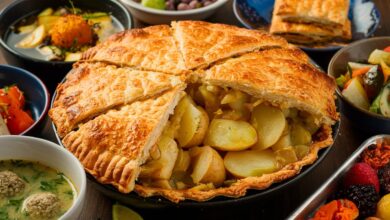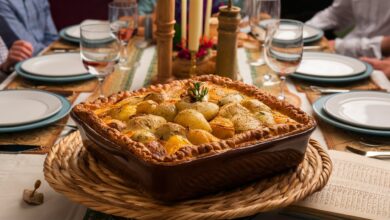Discovering the Golden Secrets of Perfect Mămăligă

In the rich tapestry of Romanian cuisine, few dishes are as beloved as Mămăligă. This humble yet versatile cornmeal dish has won the hearts of many, from traditional Romanian households to gourmet chefs exploring European culinary heritage. But what truly makes Mămăligă so special? Join us as we explore the secrets behind crafting the perfect Mămăligă, offering insights and tips for both novice and seasoned home cooks.
A Time-Honored Tradition in Every Grain
Mămăligă is more than just a dish; it’s a symbol of Romanian culture and tradition. Historically, it served as a staple food for peasants, providing nourishment and warmth. Its origins trace back to when maize was first introduced to Europe in the 16th century. Over time, Mămăligă evolved from a simple peasant meal to a cherished national treasure. Today, it holds a revered place in Romanian cuisine, celebrated for its adaptability and comforting flavors.
For Romanian families, preparing Mămăligă is nearly an art form. It embodies a connection to their roots and the land’s bounty. This dish is often more than sustenance; it’s a token of love and togetherness, bringing people to gather around the table. Whether enjoyed plain or with various toppings, Mămăligă has retained its status as a beloved staple across generations.
In understanding Mămăligă’s significance, we gain a deeper appreciation for its cultural roots. It’s fascinating to see how a dish that began as a necessity has become a cherished culinary tradition, showcasing the resilience and ingenuity of Romanian cuisine.
Crafting the Art of Perfect Mămăligă
Creating the perfect Mămăligă begins with selecting quality ingredients. Opt for fine yellow maize flour, as its texture and color contribute to the dish’s authentic character. You’ll also need water, salt, and a touch of butter for that velvety finish. Some might add cream or cheese for richness, but the simplest versions shine through with basic ingredients.
To start, bring water to a gentle boil in a sturdy pot, adding a pinch of salt to season. Gradually whisk in the cornmeal, ensuring no lumps form. Stir the mixture continuously, maintaining a steady simmer to develop the desired consistency. This attentive stirring process typically takes about 30 minutes, transforming the mixture into a smooth, thick porridge.
Patience is key to achieving Mămăligă’s creamy texture. As you stir, you’ll notice the mixture thickening and pulling away from the pot’s sides—a sign that it’s nearly ready. Once the desired consistency is reached, stir in a little butter for extra flavor, and your Mămăligă masterpiece is complete.
Unveiling the Secret Ingredients and Tips
While Mămăligă can be enjoyed in its simplest form, incorporating secret ingredients can elevate its flavors. Some regions add a dollop of sour cream or sprinkle of feta cheese, enhancing both taste and texture. In certain areas of Romania, home cooks infuse Mămăligă with garlic or herbs, adding a unique twist to this traditional dish.
Experimenting with different maize varieties can also yield interesting results. While yellow cornmeal is most common, white or blue cornmeal is sometimes used for different textures and nutritional benefits. The choice of cornmeal can influence the dish’s flavor profile, making every batch of Mămăligă a new culinary adventure.
For those seeking authentic Romanian flavors, consider pairing Mămăligă with regional cheeses like telemea or cașcaval. These salty, crumbly cheeses complement Mămăligă’s mild sweetness, creating a harmonious balance that delights the senses.
Serving Suggestions and Pairings to Elevate Your Plate
Mămăligă’s versatility makes it a star on any table, whether served as a side dish or the main event. Traditionally, it’s paired with sarmale (stuffed cabbage rolls) or grilled meats, providing a hearty base for more robust flavors. For breakfast, enjoy it with eggs and bacon, offering a warm, satisfying start to your day.

Modern takes on Mămăligă include serving it as a base for savory stews or topping it with sautéed mushrooms and herbs. This creative approach highlights Mămăligă’s adaptability, allowing it to shine alongside a variety of cuisines and flavors.
Beverage pairings can further enhance the Mămăligă experience. Consider a glass of robust red wine to complement the dish’s heartiness, or a light white wine to balance richer toppings. A traditional Romanian plum brandy, țuică, also pairs well, offering a spirited finish to a delightful meal.
Exploring the Health Benefits of Mămăligă
Beyond its delicious taste and cultural significance, Mămăligă also offers several health benefits. Cornmeal, its primary ingredient, is naturally gluten-free and rich in fiber, aiding digestion and promoting satiety. It’s also a good source of essential nutrients, including iron and B vitamins, supporting overall wellness.
For those mindful of their caloric intake, Mămăligă presents a lighter alternative to pasta or rice-based dishes. Its simple preparation allows for control over added fats and sugars, making it a suitable choice for various dietary preferences and needs.
Incorporating Mămăligă into a balanced diet can contribute to sustained energy levels and nutrition. Its comforting flavors and wholesome ingredients make it an excellent option for those seeking nourishing, satisfying meals.
Mămăligă’s Global Journey and Influence
While Mămăligă remains a quintessential Romanian dish, its influence extends beyond borders. In Italy, polenta—a close cousin of Mămăligă—shares similar roots and preparation techniques. Both dishes exemplify how simple ingredients can create memorable culinary experiences.
South America offers its own variations, with dishes like arepas and corn cakes reflecting Mămăligă’s adaptability. These global interpretations showcase the universal appeal of cornmeal-based dishes, each one reflecting unique cultural influences and preferences.
Mămăligă’s presence in international cuisine underscores its versatility and timeless charm. Its ability to transcend cultures while maintaining its essence speaks to the power of food in bringing people together, regardless of origin.

Wrapping Up the Mămăligă Magic
In your quest to master perfect Mămăligă, remember that it’s not just about the technique—it’s about capturing the essence of Romanian tradition and hospitality. From selecting quality ingredients to exploring creative pairings, each step in the process contributes to a memorable culinary experience.
With practice and creativity, you’ll soon be crafting Mămăligă that’s both authentic and personalized to your tastes. Whether you’re a seasoned cook or new to Romanian cuisine, this dish invites you to explore, experiment, and savor every bite.
We invite you to share your Mămăligă creations and experiences with fellow food enthusiasts. Your unique touches and adaptations contribute to the rich tapestry of this beloved dish, fostering a sense of community among Mămăligă lovers worldwide.



